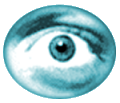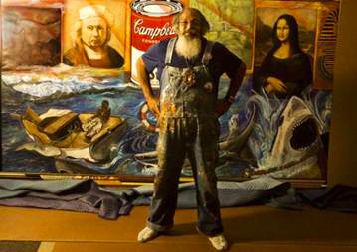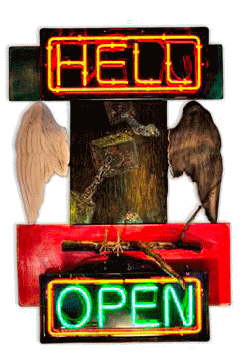
 |
 |

| (...)
Back in the eighties when his art entered the Metropolitan museum, and the gurus at “Art in America” judged him to be one of Texas’s most important artists, Bert Long attained major art world recognition. His style was compared to a mixture of folk art and Surrealism, which isn’t
too lame a description for paintings with guns or a human brain attached. Literary and art historical invocations are his works’ most interesting aspects, and undoubtedly the thing that moves collectors to pay those prices. Bert’s intellectual excursions are far reaching, and when they drive his art, as in the 2010 works based on “The Red Book,” Carl Jung’s journal, it must not be missed.
Bert Long was awarded a Prix de Rome. It was impossible to live and work in that part of Rome, in and around the American Academy’s Villa Aurelia with views of antiquities and medieval and Renaissance treasures, and not be profoundly impacted. Remaining in Europe after completing his fellowship widened Bert’s art education, and his impressions were synthesized into works such as the painting of Piero della Francesca’s Duke of Urbino, into which he inserted his own black man’s face. Here the theme was more than a black man’s distance from European cultural heritage. Bert made himself Duke Frederico de Montefeltro, a prince who so much revered learning, he had the classics read to him while he ate. Bert’s gift to local kiddies was to incorporate into “Art/Life,” his mural at the Looscan Library, images by daVinci, Rembrandt, Monet, van Gogh, Whistler and Warhol. If such images manage to stir sensibilities and yearnings in only one child, we’re better off.  Bert Long and Looscan Library mural, 2009, photo taken by Billy Smith for the Houston Chronicle Sartre defined Hell as other people, no doubt having suffered torment among the intellectually bland? In Bert’s hands, Hell has tacky neon signs, and typical of his art, is death haunted. See Bert Long’s newest artworks at Vaughan Christopher Gallery through April 28. So you can properly plan, Vaughan Christopher’s gallery hours are weird and unsuitable for working people. The gallery will accommodate you in the evening and on weekends if you call for an appointment.  |

| (...)
"Bert Long's RED Book" Houston art scene fixture Bert Long presents 18 new pieces based on The Red Book, Carl Jung's personal art journal that was published for the first time last year. Jung's artwork was based largely on the symbolism of dreams, and Long mines his own personal unconscious for this show, which manages to incorporate elements evocative of Jung's personal style. Many of Long's works utilize collage; they're assemblages of objects with paintings. Several of the works on display employ deconstructed pinewood frames beautifully stained with acrylic, giving the paintings a somehow "bookish" look. Self Examination, literally the theme of the show, evokes the surrealists — Tanguy in particular — with its blobby shapes and oozy texture. It's Long examining his body's output, both physically and psychically. Stumped is a nightmare vision of a human heart on fire and dripping with water, perched on a leg and coiled with a green snake. It's ubiquitous symbolism, perhaps, but Long's presentation is powerful. Beware after viewing: Long's work, appropriately on exhibit at the Jung Center, might provoke a restless night or two.
(...) Troy Schulze, May 26, 2010, Houston Press |

| (...)
Long Life. The MFAH showcases autobiographical work by a Houston legend. Full article...
(...) Kelly Klaasmeyer, July 13, 2006, Houston Press |

| (...) Bert Long's two contributions are just plain bad. The painting, "Crying Time," reminds me of an icon on black velvet. Depicted in the vertical rectangular canvas are two disembodied, tearshedding eyes at the top; two pieces of wood crossed to form an "X", and an artist's palette, from which paint drips like blood. Is this the blocked artist or the embarrassed muse? | |
| Probably the latter, viewing Long's "Ultimate Vision", a small mixed media sculpture bearing a distinct resemblance to the gray hunks of snow recently on our streets. To this chunk Long has affixed shards of mirrors, eyes that roll in their plastic casings, and used paint brushes. This work relates to the largely self-taught artist's stint as a cook in the Marines, where he excelled in carving ice sculptures. | |
|
Long, 41, is more successful in his other roles as editor and publisher of Houston Artscene, a
local art tabloid, and judging from the reams of material sent to the gallery curator - art
promotion.
(...) CATHERINE, FOX, febrero - 1982. The Atlanta Constitution. |

| (...)
Among paintings of more local subject matter, I liked Bert Long's "Faceless America," a sort of
Grant Wood put-down in which an old-fashioned farmer, his wife and their baby stand behind a table
groaning with produce, mirrors for their faces, a hook for his hand.
(...) GRACE GLUECK (" Fresh paint" at P.S.I (review))., 25 - mayo - 1985. The New York Times |

| (...) The showdown (Alternative Museum, NYC), presumably, is with New York. As a musical anthem to the show, California artist Terry Allen provided a twanging cowboy lament - played throughout the galleries about a truckload of art sent out from the big city "to chide, cajole, humble and humiliate the Golden Bear." The truck overturns, catches fire, "and what the critics have cheered / Is now shattered and queered / And their noble reviews / Have been stewed on the road." | |
|
Maybe so, but some Texas art appears to have been "stewed on the road" rather longer than its New York counterparts. Rowdiness is a basic condition in this show. It turns up in John Alexander and Bert Long's outrageous video satire on the Ku Klux Klan, whose members are shown gleefully sticking knives in watermelons and chewing on the pieces. It turns up again in Mel Casas's banner of bullshit (literally, a painting of a bull's head and a pile of turds). (...)
(...) KAY LARSON, 16 - mayo - 1983. New York |

| (...) There isn't anything in the show that's that specific (Solipsistic Art). I found a group of Bert Long's works that are truly universal in their statement. He's a real fixture on the Houston scene and has given a lot of energy to it. His painting called "Faceless America" is an amazing work. It's not just about Bert's experience as a Black person. The figures are not black or white; their faces are all mirrors, so they're blank. Some of them are cracked mirrors. This painting has a totally hallucinatory effect, but it comes out of a real American experience. | |
|
Added by the interpreter writer, not original text
(...) BARBARA ROSE, verano - 1985. Artspace Magazine Houston, Texas. (From an Interview about "Fresh Paint" at Museum of Fine Art, Houston) |

| (...) In his catalogue statement (Fresh Paint Museum of Fine Art), Bert Long speaks of the vision that turned him away from abstract form. He wanted to find recognizable figures capable of dealing directly with social and personal matters - not that he has completely abandoned abstraction. Long's skies sometimes look like passages of colour-filled paintings. Proliferating leaves read as sheer pattern. But those leaves always assert their leafiness. A landscape insists on being seen as the setting where figures, squared-away to the picture plane, face us-on~ it is not clear who they are, or who is facing whom, because their faces are looking-glasses. Long invited us to face ourselves. | |
|
No label clarifies the experience of looking at, or into, Long's paintings. Labels are never
in themselves, enough.
(...) CARTER RATCLIFF, verano 1985. Artspace. Howton |

| (...)
One of the state's wildest and most eccentric talents, Mr. Long has seen his career take
off since his Dallas Museum of Art exhibit last spring. Several important museums have
acquired his works over the past year, among them the Metropolitan Museum of Art in New
York and the Archer M. Huntington Art Gallery at the University of Texas at Austin.
(...) JANET KUTNER, 17 - mayo - 1989. 7, The Dallas Morning News. |

| (...) Long's work most often fits into the 'ism' of surrealism in that his images and compositions emerge from dreams and push their way onto the canvas with little interference from Long. The artist, a huge, exuberant and energetic man with a voracious appetite for knowledge and experiences, makes art with an extreme boldness and sense of freedom, qualities that are certainly derived in part from not being burdened by academic training. | |
| Long, who was born in Houston 52 years ago, has the audacity and self-confidence to push his artwork to the edge and sometimes over it. Totally undaunted by any conventional notions of what art should be or look like, he creates objects that temporarily verge on ugliness yet most often prove themselves on close inspection to be beautiful, carefully and delicately painted with layers of paint, color and glaze. | |
|
Often incorporating found objects, especially his trademark plastic eyeball (for seeing
out and in), symbols such as hearts, hands and paintbrushes, as well as direct references
to himself, Longs objects have a strong physical sense, yet they are metaphysical and
spiritual too.
(...) SUSAN CHADWICK, 25 - January - 1992. The Houston Post. |

| (...) That restive spirit is prompting Long to abandon Houston at the height of his success; before his show has even closed, he and Connie will have taken up residence in the Spanish village of Berzocana, where they visited on a brief sabbatical from the American Academy. Long, who believes that the absence of a history is a particular lacuna in the black experience, admits he has gotten hooked on the past: "I can no longer imagine walking down the street and not looking up and seeing twelfth- and thirteenth- century buildings." | |
| The Spanish influence is already evident in the most visually sophisticated piece in the CAM (Solo Exposition, Contemporary Museum of Art Houston) show. Homage to Picasso is a potpourri of references to the Spanish master; a T-shaped handle from a child's scooter recalls Picassos use of a bicycle seat for a bull's head, while the vibrant patterning and a pasted news clipping an art review that begins Bert Long's work is seriously ugly recall elements of Picasso's Cubist phases. This work is seriously sublime, with a seamless construction that indicates Long is beginning to focus the undeniable energy he brings to making art, that he is ready to synthesize rather than merely haphazardly quote his many stylistic sources. | |
|
Long's ongoing evolution as an artist shouldn't be surprising, considering his late start,
in terms of experience he's the equivalent of a typical 35-year-old artist just entering
maturity. And this CAM show, Long's first one-man exhibit in a Houston museum, suggests
that the most remarkable aspect of his extraordinary career is that his considerable talent
is only beginning to emerge.
(...) MICHAEL ENNIS ('Long Shot'), February - 1992. Texas Monthly. |

| (...)
Bert Long (from Houston, Texas, no less) has larger works in this New York solo debut of
painting constructions at Allan Stone. A Thelonius Monk / Rosie-Grier looking person, he
does his own take off on modern painting, but of the Abstract Expressionist sort. His parodies
are not done with a twinkle but with a hand reaching out, or a circle of burned out roses
around a dark photo of himself and his wife. He indicates Birth, Creation, Victory / Death,
by means of imagery. He thinks out his metaphors and employs them in very literal fashion.
(...) WILL GRANT, 16 - June - 1990. Artspeak New York. |

| (...)
When I first walked through Bert Long's outrageous world at Lew Allen, my first impulse was
to run out into the streets and joyfully scream out his name, Bert! Bert! over and over again. Hopefully the entire world would come running, or at least a few cops would venture off the Plaza and support my claim that Long is the most demented, daring, and damn funky artist this town has seen in a mighty long time. Longs work is a glorious collision of the intellectual boundary shatterings pioneered by Marcel Duchamp, and the homespun folk art musings of Howard Finster. He posses that rare gift of being able to go over the top conceptually and vent restraint in the execution of his ideas. (...) ZEKE ZEMANTHIS, 8 November 1991. Santa Fe, New Mexico Weekly Arts & Entertainment Magazine. |

| (...) But deceptively spare and almost lyrical is Legacy, a personal favorite, which unites five of Long's photographs into a piece that is a homage to Gulf Coast beaches. Editing the work down to these pieces would have increased the impact of the installation, but with Long's theme of excesses of American society, it's hard to fault it. | |
|
(...) ANNE H. ROBERTS, 2 May 1990. Public News, Houston, Texas (This Land: The State of Texas) |

| (...)
Bert Long's paintings are seriously ugly. He favors a lurid palette of blues and purples against
a ground of paper-bag brown which he likes to highlight with day-lo yellow and green. He builds
up his frames with lathing and plaster so that they often dominate the paintings themselves, and
he adds to their bulk with broken glass, plaster-cast body parts, bones, and whatever else he
finds. As a result, even his smallest works have a vulgar, screaming intensity. They pose a
genuine challenge to any canon of aesthetic credibility, no matter how loosely it might be applied.
(...) CHARLES DEE MITCHELL, 27 April 1989. Dallas Observer. |

| (...)
When asked who is the most important Texas artists are, those who serve as models for
young artists, for example most people come up with the same group of names:
alphabetically, they are John Alexander, Joseph Glasco, Bert Long, James Surls and
Michael Tracy. Stylistically these artists have little in common, though they have all been
influenced by a mixture of folk art, Mexican art and Surrealism.
(...) JAMEY GAMBRELL (Art Capital of the Third Coast), April 1987. Art in America. |

| (...)
Bert Long, in his usual media extravaganza, seduces the senses into visually enjoying art
which packs a potent indictment upon troubling human issues society seeks to evade.
Where Angels Fear to Tread features a brown and white pieced carpet runner leading to a
closed door with broken mirror pieces. The installation is about the subliminal unwelcome
Blacks receive. It is shattering for Blacks to experience that the door is still really
closed to them. Any openness is mere illusion, token gesture, broken by the actual
reality of entrenched racism.
(...) JANA VANDERLEE, November 1989. The Houston Arts. |

| (...)
The artists from Los Angeles present far and away the most imposing group in the
exhibition (Phoenix Biennial Art Museum, 1987) (save for Judd and painter Bert Long,
the Texans are unexpectedly wan).
(...) CHRISTOPHER KNIGHT, 30 August 1987. Los Angeles Herald Examiner. |

| (...)
Let's hope Texas artist Bert Long avoids the speed traps on his cross-country drive to Phoenix,
because if not, he might have difficulty explaining that glass jar on the seat. It contains a human brain in formaldehyde. "But officer, it's art!" he might say. Looks like a human brain to me, the patrolman probably would reply (as any sensible patrolman would), looking very suspicious. And Long would proceed to explain how the brain is really a metaphor for the mysterious origins of master painter Vincent van Gogh's genius. Which probably would buy him a ticket to the nearest padded cell. And you can't help but wonder what will happen when Long reaches the fruit-and-vegetable inspection station at the border. All kidding aside, the brain is the centerpiece of Long's art work, Van Gogh - obviously a mixed-media piece - which will be exhibited in the Phoenix Art Museums contemporary Biennial (...) LYNNE PYNE, 19 August 1987. The Phoenix Gazette. |

| (...)
Consider his painting Bert Long from Houston, Texas. In this unique, witty work, Long substituted his self-portrait for the Duke of Urbino as portrayed by Piero della Francesca in the 15th century. Long painted it in traditional ways, emulating the palette and brushwork of his model. No stones bones or glitter here.
He also chose to replace with his own likeness that of a nobleman and important collector as he was immortalized in the picture by a venerated master of Renaissance Europe. The fact that Long is black adds poignancy and humor to the appropriation. The exuberant self-confidence evident here always has been part of Long's makeup. He created a very different kind of self-portrait in In Vino Veritas. (In Wine Lies the Truth), the largest work in the exhibit. Like Bert Long, it alludes to art history, as well as addressing the perpetual battle of myth as truth, reality vs. illusion, (...) Patricia Johnson, Houston Chronicle, Jan 1992 |

 |
Project Essays | Photographs | Events | Public Projects | Videos | Exhibitions | Reviews | Links | Guestbook